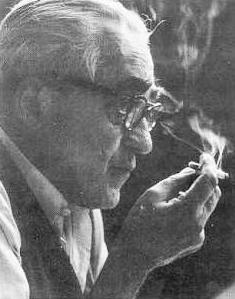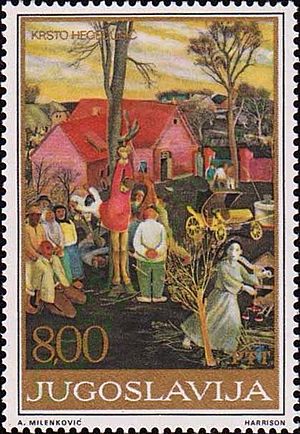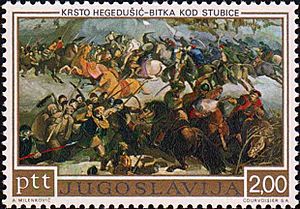Krsto Hegedušić facts for kids
Krsto Hegedušić (born November 26, 1901 – died April 7, 1975) was an important Croatian artist. He was a painter, an illustrator, and even designed sets for plays. He is most famous for his paintings that showed the tough lives of Croatian farmers. His style was often like "naive art," which means it looked simple but had deep meaning. He also helped start a group of artists called the Earth Group.
Contents
Who Was Krsto Hegedušić?
Krsto Hegedušić was born in a town called Petrinja. When he was eight years old, his father passed away. After that, his family moved back to their home village of Hlebine. This village was in a region called Podravina, which later became very important in his art.
Early Art Training
In 1920, Krsto started studying at the Arts and Crafts College in Zagreb. Here, he began painting peaceful scenes of Podravina. His teachers, Vladimir Becić and Tomislav Krizman, helped him learn more about art. However, they didn't change his unique painting style.
Studying Art in Paris
In 1926, Krsto Hegedušić received a special scholarship from the French government. This allowed him to spend two years in Paris, France. While there, he studied the works of an old Dutch painter named Pieter Brueghel the Elder. Brueghel was known for painting scenes of everyday life, especially farmers, which likely inspired Hegedušić.
Starting His Art Career
Krsto Hegedušić had his first art show in 1926 with another artist, Juraj Plančić. In his paintings, he started to show social issues. He wanted to highlight how Croatian farmers were being treated unfairly.
Founding the Earth Group
In 1929, Hegedušić met other artists like Ivan Tabaković, Oton Postružnik, and Leo Junek in Paris. Together, they formed a group called Zemlja. "Zemlja" means "soil" or "earth" in Croatian. This was the first art group in Croatia that supported Marxism, a way of thinking about society and fairness. Hegedušić was seen as the leader and main thinker of this group. Their paintings, like The Accordionist and The Flood, were not just pretty pictures. They were meant to make people think about social problems.
The Hlebine School of Art
In 1930, Krsto Hegedušić started something very special called the Hlebine School. This was a movement for "naive art." He taught young, talented farmers from his home village to paint. One of his students, Ivan Generalić, became famous around the world for his art.
Art and Literature
In 1933, Hegedušić published a book called Podravina Motifs. This book combined his drawings with a poem by a famous Croatian writer, Miroslav Krleža. Today, this book is considered a masterpiece of Croatian literature. Krleža even wrote a script for a documentary film about Hegedušić in 1962.
Teaching and Later Life
In 1936, Hegedušić began teaching at the Academy of Fine Arts Zagreb. During the 1930s, he was arrested a few times because of his political views. When the Ustaša government came to power in 1941, he was protected by Archbishop Stepinac. During the war, he worked on different art projects, including religious paintings.
After World War II, a new government came to power in Yugoslavia. In 1945, Hegedušić became a professor at the Zagreb Academy. In 1950, he started a special "master's studio" there. Many talented painters, like Miroslav Šutej and Zlatko Sirotić, studied with him in this studio.
New Artistic Directions
After the war, Hegedušić also started painting some surrealistic pictures. These paintings were dream-like and sometimes strange. For example, his painting Dead Waters might remind you of plays that explore confusing or absurd ideas.
Later in his life, paintings like The Bridegroom, the Ox and the Pump (from 1969) showed his thoughts on city life. Between 1971 and 1973, he worked on a large series of powerful frescoes for a war memorial in Tjentište.
Krsto Hegedušić also illustrated many books and designed sets for ballet and theater shows. He passed away in Zagreb in 1975.
Images for kids







